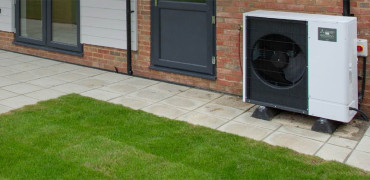Breathing is something we all do constantly and subconsciously to stay alive.
But, how often do we think about the air we breathe? What exactly are we breathing in, and what might its affects be on our bodies?
Whether at home or in the workplace (where it is a legal requirement), ventilating the air around us has become an increasing concern to maintain a healthy atmosphere, and subsequently, healthy bodies.
Ventilation regulates air quality in the background while we go about our daily lives, many of us rarely (if ever) sparing a thought for its importance.
Bringing in fresh air doesn’t have to mean throwing away all of your heat
Why we need ventilation
During the Covid-19 pandemic, many of us became vigilant about opening windows under guidance from the government and the World Health Organisation to reduce the risk of spreading the virus indoors.
This is because in poorly ventilated spaces, infected respiratory particles can linger, effectively trapping the virus inside, where it can be picked up by those who use the space.
Maintaining good Indoor Air Quality* (IAQ) (i.e. by letting out stale, impure or polluted air and bringing in fresh air from outside) is not only essential in reducing the spread of air-borne viruses, but also in reducing exposure to a wide range of air pollutants, and preventing condensation and mould growth.
Studies have also shown links between good ventilation and improved health, focus and better quality of sleep, according to The Health and Safety Executive.
*Measured in ppm (parts-per-million) of CO2. Generally, 450ppm-1000ppm is considered safe IAQ, with 450 being excellent, well-ventilated air and 1000 being acceptable but indicating a need for better ventilation. Anything consistently over 1500ppm in an indoor space indicates poor IAQ and steps should be taken to improve ventilation.
How ventilation works
Buildings can be ventilated in three ways:
- Naturally (e.g. by opening windows and allowing outside air to flow freely into the building)
- Mechanically (e.g. by installation of ventillation units)
- A combination of the above
In natural ventilation, the wind drives airflow through the building, helping to reduce dust levels and things like chemical vapours from cleaning. Depending on weather and pollution conditions in the surrounding area, however, natural ventilation is not always an ideal or complete solution for some.
This is where Mechanical ventilation steps in; it uses fans and ducts and control systems to ventilate buildings, and it is generally independent of the outside environment.
Ventilation units such as Mitsubishi Electric’s RVXT3 Lossnay unit are designed to keep the air in commercial buildings fresh while extracting stale air.
Additionally, when it comes to IAQ, the unit is compatible with the Mitsubishi Electric PZ-70CS(W)/(D)-E CO2 sensor which regularly measures the CO2 levels in a room and adjusts the unit’s airflow accordingly to keep air fresh in an energy efficient manner.
The RVXT3 is also durable and easy to maintain with dual-barrier coated fans that prevent the build up of dust and grease, helping to ensure a safe IAQ.
The added advantage of Lossnay
With natural ventilation you can get lots of fresh air blowing through your rooms via open windows. You also lose whatever heat you have built up inside as the stale indoor air is replaced by the fresh outdoor air.
This is a very inefficient way of introducing fresh air, especially in the colder months when the outdoor air can be as cool as 5 degrees, yet we want the indoor air to be a comfortable 20 degrees. That’s 15 degrees of heating that is literally escaping through the window.
With mechanical ventilation, it is also possible to introduce heat recovery, and these systems are now known as Mechanical Ventilation with Heat Recovery (MVHR).
That’s where the unique design and paper core of the RVXT3 Lossnay MVHR comes into its own as the outgoing air flow passes over the incoming air, transfering up to 90% of the heat from one to the other, while keeping them completely seperate.
That means the stale air is gone but there is much less work for your heating system to do to bring the incoming air up to the right temperature.
BASH that stale air
In association with the BESA (Building Engineering Services Association) we have produced two independent guides to IAQ which can be downloaded for free on our document library:
Both offer straighforward information on the key issues and the Award-winning BASH Guide also includes a step-by-step process and a useful tick-box form to help building owners work out the best way of improving the air quality in their building.
How to maintain ventilation units
It is crucial to keep ventilation units maintained in order to ensure they are still keeping the air in their given space clean, helping to avoid such nasties as mould, contaminents and airborne viruses.
Stale and polluted air can cause a build-up of bacteria in ventilation systems, making them less effective over time if not maintained properly. The Chartered Institution of Building Services Engineers (CIBSE) notes that different ventilation systems may have different maintenance procedures, so it is best to contact the supplier or installer for more information on these.
The Renewable Energy Hub UK suggests the following procedures for maintaining either domestic or commercial ventilation systems:
Taking time to learn about and maintain your ventilation system is paramount to ensuring good IAQ, and in turn, a clean and comfortable atmosphere you can thrive in. To find out more about ventilation, do check out Mitsubishi Electric’s Ventilation Brochure.
|
Task |
Reason |
Frequency |
|
Checking for dirty filters |
Dirty filters cause a reduction in IAQ and reduction in efficiency |
Every 6-12 months |
|
Check ductwork |
Make sure you’re not losing static pressure from leakages in ductwork |
Once a year |
|
Cleaning dirty heat exchange surfaces |
A build up of dirt could reduce efficiency |
Once a year/ as required |
|
Replacing damaged damper seals |
Damaged damper seals may lead to difficulty in controlling airflow |
Once a year/ as required |
|
Check controls are calibrated correctly |
If controls are not set accurately, the unit may be inefficient or provide insufficient ventilation |
Once a year |
Handy Resources:
- CIBSE website: Ventilation in Buildings - Top Tips | CIBSE
- The Health & Safety Executive website: Overview - Ventilation in the workplace
- World Health Organisation website: Coronavirus disease (COVID-19): Ventilation and air conditioning
- The Renewable Energy Hub UK: Maintenance of Heat Recovery and Ventilation Systems UK
- Mitsubishi Electric: Guide to Indoor Air Quality (IAQ)
You can also find out more about our full range of advanced commercial ventilation systems here.
Amy McEwen is a Policy and Public Affairs Graduate for Mitsubishi Electric




